Sony Trinitron KV-XA29, Trinitron KV-XA29M50, Trinitron KV-XA29M61, Trinitron KV-XA25M50, Trinitron KV-XA25 User Manual
...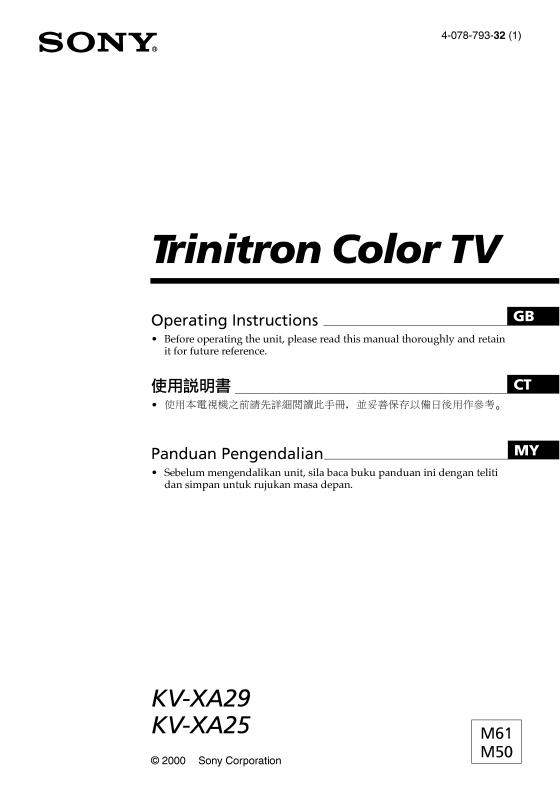
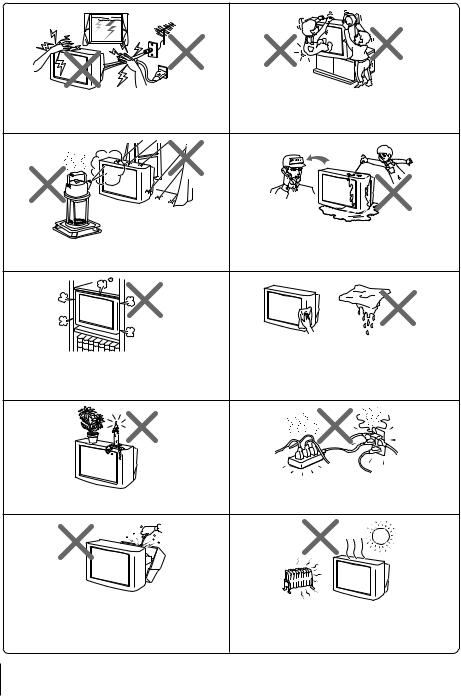
WARNING
•Dangerously high voltages are present inside the TV.
•TV operating voltage: 220 – 240 V AC.
For your own safety, do not touch any part of the TV, the power cord and the antenna cable during lightning storms.
For children’s safety, do not leave children alone with the TV. Do not allow children to climb onto it.
To prevent fire or shock hazard, do not expose the TV to rain or moisture.
Do not operate the TV if any liquid or solid object falls into it. Have it checked immediately by qualified personnel only.
Do not block the ventilation openings of the TV. Do not install the TV in a confined space, such as a bookcase or built-in cabinet.
Clean the TV with a dry and soft cloth.
Do not use benzine, thinner, or any other chemicals to clean the TV. Do not scratch the picture tube.
Do not place any objects on the TV.
Do not plug in too many appliances to the same power socket. Do not damage the power cord.
Do not open the cabinet and the rear cover of the TV as high voltages and other hazards are present inside the TV. Refer servicing and disposal of the TV to qualified personnel.
Your TV is recommended for home use only. Do not use the TV in any vehicle or where it may be subject to excessive dust, heat, moisture or vibrations.
2

Table of Contents
Using Your New TV |
|
Getting Started ............................................................................................. |
4 |
Step 1: Connect the antenna .................................................................. |
4 |
Step 2: Insert the batteries into the remote .......................................... |
5 |
Step 3: Preset the channels automatically ........................................... |
5 |
Connecting optional components ............................................................. |
6 |
Securing the TV ............................................................................................ |
8 |
Watching the TV .......................................................................................... |
9 |
Your Using
TV New
Advanced Operations |
|
Selecting the picture and sound |
|
modes .................................................. |
12 |
Viewing your favorite channels ....... |
13 |
Listening with surround sound ....... |
14 |
Enjoying stereo or bilingual programs |
|
(KV-XA29M61/XA25M61 only) ...... |
15 |
Viewing Teletext |
|
(KV-XA29M61/XA25M61 only) ...... |
17 |
Adjusting Your Setup (MENU) |
|
Introducing the menu system .......... |
19 |
Changing the “PICTURE” |
|
setting ............................................ |
21 |
WARNING (continued)
GB
Changing the “SOUND” setting |
.... 23 |
|
Changing the “SETUP” |
|
|
setting ............................................ |
|
25 |
Changing the Channel Preset |
|
|
(“CH PRESET”) setting |
.............. |
27 |
Additional Information |
|
|
Self-diagnosis function ...................... |
|
30 |
Troubleshooting ................................. |
|
31 |
Troubleshooting Shortcuts ................ |
|
34 |
Overview of controls ......................... |
|
36 |
Specifications ...................... |
Back cover |
|
Install the TV on a stable TV stand and floor which can support the TV set weight. Ensure that the TV stand surface is flat and its area is larger than the bottom area of the TV.
Pull the power cord out by the plug. Do not pull the power cord itself. Even if your TV is turned off, it is still connected to the AC power source (mains) as long as the power cord is plugged in. Uuplug the TV before moving it or if you are not going to use it for several days.
3

Using Your New TV
Getting Started
CAUTION
•Do not plug in the power cord until you have completed making all other connections; otherwise a minimum leakage current might flow through the antenna and other terminals to ground.
•To avoid battery leakage and damage to the remote, remove the batteries from the remote if you are not going to use it for several days. If any liquid that leaks from the batteries touches you, immediately wash it away with water.
Step 1 
Connect the antenna
If you wish to connect a VCR, see the Connecting a VCR diagram below.
Rear of TV
Antenna cable (not supplied)
or
IEC connector |
(not supplied) |
Antenna cable (not supplied) |
: Signal flow |
|
Connecting a VCR
Rear of TV
To watch the video input, press t (see page 10).
Antenna cable (not supplied)
To antenna
output VCR
To 8 (antenna)
R L Y CB CR
1 |
2 |
3 |
AUDIO VIDEO
R L
S video cable (not supplied)
VIDEO IN
VIDEO OUT
|
To |
|
To video |
To S video (S video input) |
|
and audio |
output |
|
outputs |
|
To t 1, 2 or 3 |
Audio/Video cable (not supplied) |
||
(video input)
4 Using Your New TV
 (yellow)
(yellow)
-L (MONO) (white)  -R (red)
-R (red)
: Signal flow
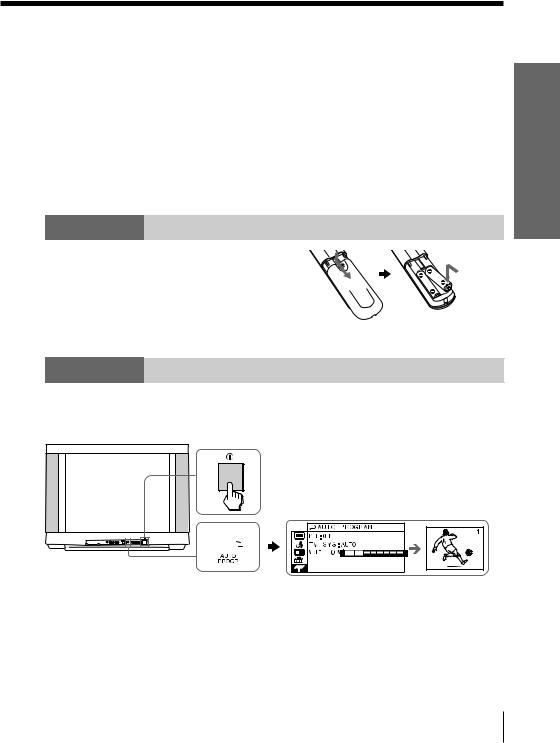
Notes
•If you connect a monaural VCR, connect the yellow plug to  (the yellow jack) and the black plug to
(the yellow jack) and the black plug to  -L (MONO) (the white jack).
-L (MONO) (the white jack).
•If you connect a VCR to the 8 (antenna) terminal, preset the signal output from the VCR to the program number 0 on the TV.
•If both  (S video input) and t 1 (video input) at the rear of your TV are input at the same time, the
(S video input) and t 1 (video input) at the rear of your TV are input at the same time, the  (S video input) is automatically selected. To view the video input to t 1 (video input), disconnect the S video cable.
(S video input) is automatically selected. To view the video input to t 1 (video input), disconnect the S video cable.
•Do not connect video equipment to the t 3 (video input) jacks at the front and the rear of your TV at the same time; otherwise the picture will not be displayed properly on the screen.
•When no signal is input from the connected video equipment, the TV screen becomes blue.
Step 2
Insert the batteries into the remote
Your Using
TV New
Note
• Do not use old batteries nor use different types of batteries together.
Step 3
Preset the channels automatically
Front of TV
1
2 
Tips
•If you want to stop the automatic channel presetting, press MENU.
•If your TV has preset an unwanted channel or cannot preset a particular channel, then preset your TV manually (see page 28).
Note (KV-XA29M50/XA25M50 only)
•During automatic channel presetting, your TV screen will indicate “B/G”, “I”, ”D/K” or “M” for the TV system (“TV SYS”).
Using Your New TV 5

Connecting optional components
You can connect optional audio/video components, such as a VCR, multi disc player, DVD, camcorder, video game or stereo system.
To watch the video input of the connected equipment, press t (see page 10).
Connecting a camcorder/video game equipment using the t (video input) jacks
Front of TV
To  (S video input)
(S video input)
 S video cable (not supplied)
S video cable (not supplied)  Audio/Video cable (not supplied)
Audio/Video cable (not supplied)
To t 3 (video input) |
To video and |
Camcorder |
audio outputs |
L (MONO) |
R |
or |
|
|
To S video output |
|
|
Video game |
3 |
|
equipment |
|
|
: Signal flow |
Notes
•You can also connect video equipment to the t 1 ,2 or 3 (video input) jacks at the rear of your TV.
• If both |
(S video input) and t 3 (video input) at the front of your TV |
|
are input at the same time, the |
(S video input) is automatically |
|
selected. To view the video input to t 3 (video input), disconnect the S video cable.
•Do not connect video equipment to the t3 (video input) jacks at the front and the rear of your TV at the same time; otherwise the picture will not be displayed properly on the screen.
Connecting audio/video equipment using the T (monitor output) jacks
Rear of TV |
Antenna cable (not supplied) |
|
|
|
||
|
|
|
|
To |
Audio system |
|
|
|
|
|
antenna |
||
|
|
|
|
|
|
|
|
|
|
VCR |
output |
or |
|
R |
L Y |
CB CR |
To T |
|
|
|
(monitor |
To video and |
To |
||||
|
|
|
output) |
|||
1 |
2 |
3 |
|
audio inputs |
audio |
|
|
|
|
|
|
|
inputs |
|
|
|
(yellow) |
Audio/Video cable |
||
|
|
|
-L (MONO) |
(not supplied) |
|
|
|
|
|
(white) |
|
|
: Signal flow |
Note |
-R (red) |
|
•If you select “DVD” on your TV screen, no signal will be output at the T (monitor output) jacks (see page 10).
6 Using Your New TV

Connecting a DVD player using the t (video input) jacks
DVD player |
|
|
Rear of TV |
|
1 |
2 |
3 |
LINE OUT |
|
|
|
R-AUDIO-L VIDEO |
|
|
|
|
|
|
L(MONO) |
|
|
|
R |
|
|
|
To t 1, 2, or 3 |
|
|
|
(video input) |
Audio/Video cable |
(yellow) |
|
|
(not supplied) |
-L (MONO) (white) |
||
|
-R (red) |
|
: Signal flow |
Connecting a DVD player using the  (component video input) jacks
(component video input) jacks
1Connect R and L under  (component video input) on your TV to the LINE OUT, AUDIO R and L output connectors on your DVD player.
(component video input) on your TV to the LINE OUT, AUDIO R and L output connectors on your DVD player.
2Using a component video cable, connect Y, CB, and CR under  (component video input) on your TV to the COMPONENT VIDEO OUT Y, CB, and CR output
(component video input) on your TV to the COMPONENT VIDEO OUT Y, CB, and CR output
connectors on your DVD player.
DVD player
|
|
|
R L Y CB CR |
COMPONENT VIDEO OUT S VIDEO OUT |
LINE OUT |
|
|
CR CB |
Y |
R-AUDIO-L VIDEO |
To |
|
|
|
|
|
|
|
L (white) |
|
|
|
R (red) |
To audio |
Audio cable |
To |
output |
(not supplied) |
(component |
|
|
video input) |
: Signal flow
To component video output
Component video cable (not supplied)
Notes
•If your DVD player can output interlace and progressive mode signals, select
the interlace output when connecting to  (component video input) on your TV. Your TV can receive either 525i/60Hz or 625i/50Hz interlace signals.
(component video input) on your TV. Your TV can receive either 525i/60Hz or 625i/50Hz interlace signals.
•Some DVD player terminals may be labeled differently:
Connect |
To (on the DVD player) |
Y (green) |
Y |
CB (blue) |
Cb, B-Y or PB |
CR (red) |
Cr, R-Y or PR |
•Since the high quality pictures on a DVD disc contain a lot of information, picture noise may appear. In this case, adjust the sharpness (“SHARP”) in the “ADJUST” menu of the “PICTURE MODE” menu (see page 22).
Your Using
TV New
Using Your New TV 7

Securing the TV
To prevent the TV from falling, secure the TV using one of the following methods:
AWith the supplied screws, attach the band to the TV stand and to the rear of the TV using the provided hole.
or
BPutpillar.the cord or chain through the clamps to secure the TV against a wall or
20 mm
3.8 mm
A B
or
Note
• Use only the supplied screws. Use of other screws may damage the TV.
8 Using Your New TV
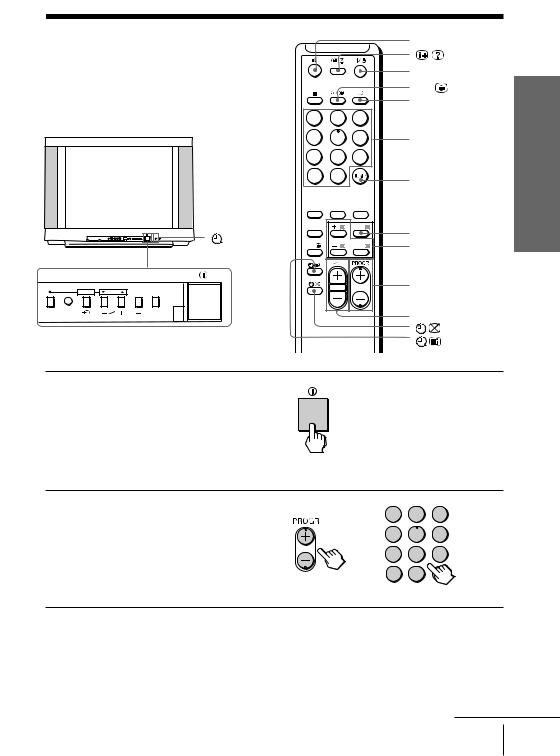
Watching the TV |
% |
This section explains various functions |
|
|
?/1 |
||
|
|
t |
|||
and operations available while watching |
|
|
|||
|
|
a |
|||
the TV. Most operations can be done |
|
|
|||
|
|
|
|||
using the remote. |
1 |
2 |
3 |
|
|
|
|
4 |
5 |
6 |
Number buttons |
|
|
7 |
8 |
9 |
|
|
|
-/-- |
0 |
|
JUMP |
|
|
|
|
|
|
|
|
SOUND |
SURROUND FAVORITE |
|
|
|
|
MODE |
|
||
|
|
PIC MODE |
|
MENU |
MENU |
|
|
1 indicator |
|
|
|
|
|
|
|
+/–/ENTER |
|
|
|
A/B |
|
ENTER |
|
|
|
|
|
||
ENTER |
SELECT |
|
|
|
PROGR +/– |
|
|
|
|
||
AUTO |
|
|
|
|
2 +/– |
MENU PROGR |
|
PROGR |
|
|
|
Your Using
TV New
1 Press ! to turn on the TV.
When the TV is in the standby mode (the 1 indicator on the TV is lit red), press ?/1 on the remote or PROGR +/– on the TV.
2 Press PROGR +/– or number buttons to select the program number.
For double digit numbers, press -, then the number (e.g., for 25, press -, then 2 and 5).
1 2 3
4 5 6
or
7 8 9
-/-- 0
To select a program number quickly
(1)Press and hold PROGR +/–.
(2)Release PROGR +/– when the desired program number appears.
Note
• When you select a program number quickly, the picture may be disrupted.
This does not indicate a malfunction.
continued
Using Your New TV 9

Watching the TV (continued)
Additional tasks
To |
Press |
Turn off temporarily |
?/1. The 1 indicator on the TV lights up red. |
|
|
Turn off completely |
! on the TV. |
|
|
Adjust the volume |
2 +/–. |
|
|
Mute the sound |
%. |
|
|
Watch the video input |
t to select “VIDEO 1”, “VIDEO 2” , “VIDEO 3” |
(VCR, camcorder, etc.) |
or “DVD”. |
|
To return to the TV program, press a (or t on the TV). |
Jump back to the previous program |
JUMP. |
number |
|
Display the on-screen information* |
. |
|
|
*The picture, sound, and either the program number or video input are displayed. The on-screen display for the picture and sound information disappears after about three seconds.
Changing the menu language
You can change the menu language as well as the on-screen language.
For details on how to use the menu, see Introducing the menu system on page 19.
1 |
Press MENU. |
MENU |
P I C T URE |
|
P I C T URE +MODE : DYNAM I C |
||
|
|
|
WI DE MODE : OF F |
|
|
|
I N T E L L I GEN T P I C : OF F |
2 |
Press + or – to select the |
|
|
||
|
||
|
“SETUP” icon ( ), then |
|
press ENTER.
ENTER |
S E T UP |
|
L ANGUAGE : ENG L I SH |
||
|
||
|
P I C ROT A T I ON |
|
|
PROGRAM S E T UP |
|
|
CO L OR S Y S : AU TO |
3 |
Make sure “LANGUAGE” is |
|
selected, then press ENTER. |
ENTER |
S E T UP |
ENG L I SH |
|
L ANGUAGE : |
|||
|
|||
|
P I C ROT A T I |
|
|
|
PROGRAM S E |
|
|
|
CO L OR S Y S : |
|
4 |
Press + or – to select the |
|
|
desired language (e.g, |
|
|
“ |
”), then press ENTER. |
ENTER 

The selected menu language appears.
To return to the normal screen
Press MENU.
10 Using Your New TV
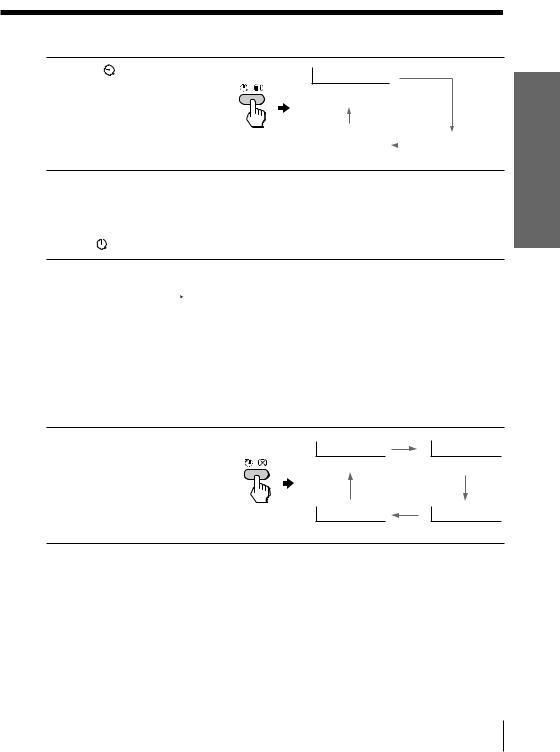
Setting the Wake Up timer
1 |
Press until the desired |
|
period of time appears. |
The Wake Up timer starts immediately after you have set it.
WAKE UP TIMER:10M
After 10 minutes
WAKE UP TIMER:OFF |
|
|
WAKE UP TIMER:12H00M |
|
|
||||
No Wake Up Timer |
|
After 12 hours |
||
2 |
Select the program number or video input you want to display when you |
|
wake up. |
|
|
3 |
Press 1 or set the Sleep timer if you want the TV to turn off automatically. |
|
The indicator on the TV lights up orange. |
To cancel the Wake Up timer
Press  until “WAKE UP TIMER: OFF” appears or turn off the TV’s main power.
until “WAKE UP TIMER: OFF” appears or turn off the TV’s main power.
Note
•If no buttons or controls are pressed for more than two hours after the TV is turned on using the Wake Up timer, the TV automatically goes into the standby mode. To continue watching the TV, press any button or control on the TV or the remote.
Setting the Sleep timer
Press  until the desired period of time appears.
until the desired period of time appears.
The Sleep timer starts immediately after you have set it.
SLEEP TIMER:30M
After 30 minutes
SLEEP TIMER:OFF
No Sleep Timer
SLEEP TIMER:60M
After 60 minutes
SLEEP TIMER:90M
After 90 minutes
To cancel the Sleep timer
Press  until “SLEEP TIMER: OFF” appears or turn the TV off.
until “SLEEP TIMER: OFF” appears or turn the TV off.
Your Using
TV New
Using Your New TV 11

Advanced Operations
Selecting the |
SOUND |
SURROUND FAVORITE |
picture and sound |
MODE |
|
PIC MODE |
MENU |
|
modes |
|
SOUND MODE |
A/B |
PIC MODE |
|
|
ENTER |
You can select picture and sound modes and adjust the setting to your preference in “PERSONAL” option.
Selecting the picture mode |
|
|
|
|
|
|
|
|
|
|
||
|
|
|
|
|
|
|
|
|
|
|||
|
Press PIC MODE |
PIC MODE |
DYNAMIC |
STANDARD |
||||||||
|
repeatedly until you get |
|
|
|
|
|
|
|
|
|
|
|
|
|
|
|
|
|
|
|
|
|
|
||
|
|
|
|
|
|
|
|
|
|
|
||
|
the desired picture mode. |
|
|
|
|
|
|
|
|
|
|
|
|
|
|
|
|
|
|
|
SOFT |
||||
|
|
|
|
|
|
|
|
|
|
|||
|
|
|
|
|||||||||
|
|
|
PERSONAL |
|
|
|||||||
|
|
|
|
|
|
|
|
|
|
|
|
|
|
Select |
To |
|
|
|
|
|
|
|
|
|
|
|
|
|
|
|
|
|
|
|
|
|
|
|
|
“DYNAMIC” |
view high contrast pictures. |
|
|
|
|
|
|
|
|
|
|
|
|
|
|
|
|
|
|
|
|
|
|
|
|
“STANDARD” |
view normal contrast pictures. |
|
|
|
|
|
|
|
|
|
|
|
|
|
|
|
|
|
|
|
|
|
|
|
|
“SOFT” |
view mild pictures. |
|
|
|
|
|
|
|
|
|
|
|
|
|
|
|
|
|
|
|
|
|
|
|
|
“PERSONAL” |
receive the last adjusted picture setting from the “ADJUST” |
||||||||||
|
|
option in the “PICTURE” menu (see page 21). |
|
|
|
|||||||
|
|
|
|
|
|
|
|
|
|
|
|
|
Selecting the sound mode
Press SOUND MODE repeatedly until you get the desired sound mode.
SOUND |
≥ DYNAMIC |
≥ DRAMA |
MODE |
|
|
|
≥ PERSONAL |
≥ SOFT |
Select |
To |
|
|
“DYNAMIC” |
listen to dynamic and clear sound that emphasizes the low and |
|
high tones. |
|
|
“DRAMA” |
listen to sound that emphasizes voice and high tones. |
|
|
“SOFT” |
listen to soft sound. |
|
|
“PERSONAL” |
receive the last adjusted sound setting from the “ADJUST” |
|
option in the “SOUND” menu (see page 23). |
|
|
Tip
•You can also set the picture and sound modes using the menu (see
Changing the “PICTURE” setting on page 21 and Changing the “SOUND” setting on page 23).
12 Advanced Operations
